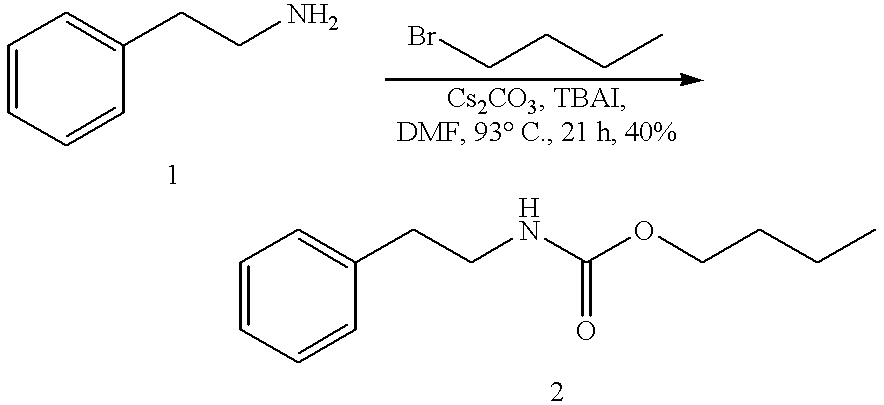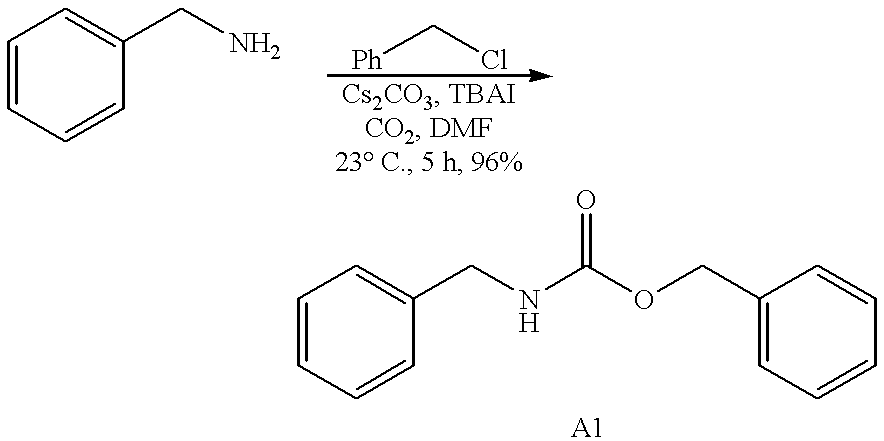Efficient carbamate synthesis
a carbamate and synthesis method technology, applied in the preparation of carbamic acid derivatives, organic chemistry, chemistry apparatus and processes, etc., can solve the problems of undesirable product racemization, lowering yield and increasing cost, and above-method drawbacks and limitations
- Summary
- Abstract
- Description
- Claims
- Application Information
AI Technical Summary
Benefits of technology
Problems solved by technology
Method used
Image
Examples
example 2
Efficient Cesium-Promoted Carbamate Synthesis in the Presence of a Carbon Dioxide Source
In a preferred embodiment, improved carbamate yield is obtained by supplementing the reaction with a continuous source of carbon dioxide, preferably by bubbling the reaction with a gas containing carbon dioxide. This example is a three-component coupling of amine (3) and n-butyl bromide, at room temperature and in the presence of a continuous source of carbon dioxide, to synthesize benzylcarbamate (4) in high yield. A yield of 96% of benzylcarbamate (4) is obtained in 3 hours at 23.degree. C. from the reaction of n-butyl bromide and benzylamine (3) in anhydrous DMF in the presence of cesium carbonate and tetrabutylammonium iodide (TBAI). ##STR2##
examples 3-25
Efficient Synthesis of Carbamates from Alkyl and Primary Amines
A useful feature of the present invention is that carbamates can be prepared by reactions of a very wide range of amines and organic electrophiles under mild conditions, as set forth in the following examples. In these examples, high yields of carbamates of the general formula R--NH--CO.sub.2 --R' are produced from a range of structurally diverse primary amines reacted with organic electrophiles, preferably organic bromides or chlorides. Reactions are carried out at mild temperatures, preferably 23.degree. C. or 0.degree. C. Examples 3-25 demonstrate the versatility of the present invention and the syntheses are described in detail below.
example 3
##STR3##
Preparation of carbamate A1: Carbon dioxide is bubbled into a stirred suspension containing benzylamine (0.22 g, 2 mmol), tetrabutylammonium iodide (2.22 g, 6 mmol, 3 eq.) and cesium carbonate (1.95 g, 6 mmol, 3 eq.) in anhydrous N,N-dimethylformamide (10 mL) at room temperature for 1 hour. Benzyl chloride (0.76 g, 6 mmol, 3 eq.) is added in one portion into the reaction and the mixture is stirred at room temperature for 5 hours. The reaction is quenched with water (20 mL) and extracted with ethyl acetate (3.times.20 mL). The resulting organic layer is then washed consecutively with water (3.times.20 mL), brine (20 mL), and dried over anhydrous sodium sulfate. Filtration and concentration in vacuo provides the crude carbamate as an oil, which is purified by silica gel column chromatography (9:1 hexanes-EtOAc) to yield the desired carbamate A1 (0.463 g, 96%). Data for A1: IR (thin film) 3331, 3087, 3032, 2957, 2897, 1690, 1534, 1455, 1266, 1140, 748 cm.sup.-1. .sup.1 H NMR (3...
PUM
| Property | Measurement | Unit |
|---|---|---|
| Polarity | aaaaa | aaaaa |
| Concentration | aaaaa | aaaaa |
| Electrophilic | aaaaa | aaaaa |
Abstract
Description
Claims
Application Information
 Login to View More
Login to View More - R&D
- Intellectual Property
- Life Sciences
- Materials
- Tech Scout
- Unparalleled Data Quality
- Higher Quality Content
- 60% Fewer Hallucinations
Browse by: Latest US Patents, China's latest patents, Technical Efficacy Thesaurus, Application Domain, Technology Topic, Popular Technical Reports.
© 2025 PatSnap. All rights reserved.Legal|Privacy policy|Modern Slavery Act Transparency Statement|Sitemap|About US| Contact US: help@patsnap.com



